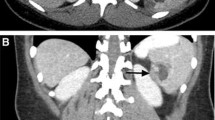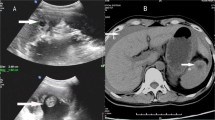Abstract
Background
Primary splenic pregnancy is a rare entity, usually treated with splenectomy.
Case presentation and review of the literature
We report the first case of conservative management of splenic pregnancy with selective embolization and intramuscular methotrexate administration. Postoperative treatment was uneventful. We have further systematically reviewed the literature upon the treatment options in case of splenic pregnancy. It has been evident that most cases were treated with spleenectomy, especially in case of active hemorrhage. Spleen preservation is rarely achieved, only in cases of hemodynamically stable, uncomplicated patients.
Conclusion
Splenic selective embolization could be a treatment option in case of uncomplicated splenic pregnancy with the benefit of splenic preservation.

Similar content being viewed by others
References
Bouyer J, Coste J, Fernandez H, Pouly JL, Job-Spira N (2002) Sites of ectopic pregnancy: a 10 year population-based study of 1800 cases. Human Reprod (Oxf, Engl) 17(12):3224–3230
Poole A, Haas D, Magann EF (2012) Early abdominal ectopic pregnancies: a systematic review of the literature. Gynecol Obstet Invest 74(4):249–260. https://doi.org/10.1159/000342997
Zhang Y, Kang D, Zhang B, Yang L, Fan Z (2016) Ectopic pregnancy causing splenic rupture. Am J Emerg Med 34(6):1184.e1181–1182. https://doi.org/10.1016/j.ajem.2015.11.011
Studdiford W (1942) Primary peritoneal pregnancy. Am J Obstet Gynecol 44:487–491
Kitade M, Takeuchi H, Kikuchi I, Shimanuki H, Kumakiri J, Kinoshita K (2005) A case of simultaneous tubal-splenic pregnancy after assisted reproductive technology. Fertil Steril 83(4):1042. https://doi.org/10.1016/j.fertnstert.2004.10.047
Yagil Y, Beck-Razi N, Amit A, Kerner H, Gaitini D (2007) Splenic pregnancy: the role of abdominal imaging. J Ultrasound Med Off J Am Inst Ultrasound Med 26(11):1629–1632
Gang G, Yudong Y, Zhang G (2010) Successful laparoscopic management of early splenic pregnancy: case report and review of literature. J Minim Invasive Gynecol 17(6):794–797. https://doi.org/10.1016/j.jmig.2010.07.004
Python JL, Wakefield BW, Kondo KL, Bang TJ, Stamm ER, Hurt KJ (2016) Ultrasound-guided percutaneous management of splenic ectopic pregnancy. J Minim Invasive Gynecol 23(6):997–1002. https://doi.org/10.1016/j.jmig.2016.05.004
Klang E, Keddel N, Inbar Y, Rimon U, Amitai M (2016) Splenic pregnancy: a new minimally invasive approach to treatment. Cardiovasc Intervent Radiol 39(9):1339–1342. https://doi.org/10.1007/s00270-016-1403-5
Hu J, Tao X, Yin L, Shi Y (2016) Successful conservative treatment of cervical pregnancy with uterine artery embolization followed by curettage: a report of 19 cases. BJOG Int J Obst Gynaecol 123(Suppl 3):97–102. https://doi.org/10.1111/1471-0528.14005
Coke GA, Baschat AA, Mighty HE, Malinow AM (2004) Maternal cardiac arrest associated with attempted fetal injection of potassium chloride. Int J Obst Anesth 13(4):287–290. https://doi.org/10.1016/j.ijoa.2004.04.009
Weledji EP (2014) Benefits and risks of splenectomy. Int J Surg (Lond, Engl) 12(2):113–119. https://doi.org/10.1016/j.ijsu.2013.11.017
Liatsos GD (2019) The immunity features and defects against primary cytomegalovirus infection post-splenectomy indicate an immunocompromised status: a PRISMA-compliant meta-analysis. Medicine 98(43):e17698. https://doi.org/10.1097/md.0000000000017698
Author information
Authors and Affiliations
Contributions
AM and DT conceived the presented clinical approach. All authors participated in patient management, and clinical data acquisition. Literature search was performed by TV and FM. Initial draft was prepared by TV, FM and AM. All authors revised it critically for important intellectual content. All authors approved the version to be published. All authors agree to be accountable for all aspects of the work.
Corresponding author
Ethics declarations
Conflict of interest
We declare that we have no conflict of interest.
Additional information
Publisher's Note
Springer Nature remains neutral with regard to jurisdictional claims in published maps and institutional affiliations.
Rights and permissions
About this article
Cite this article
Makrigiannakis, A., Raissaki, M., Vrekoussis, T. et al. Splenic pregnancy treated with transcatheter embolization and methotrexate. Arch Gynecol Obstet 303, 55–59 (2021). https://doi.org/10.1007/s00404-020-05778-x
Received:
Accepted:
Published:
Issue Date:
DOI: https://doi.org/10.1007/s00404-020-05778-x




